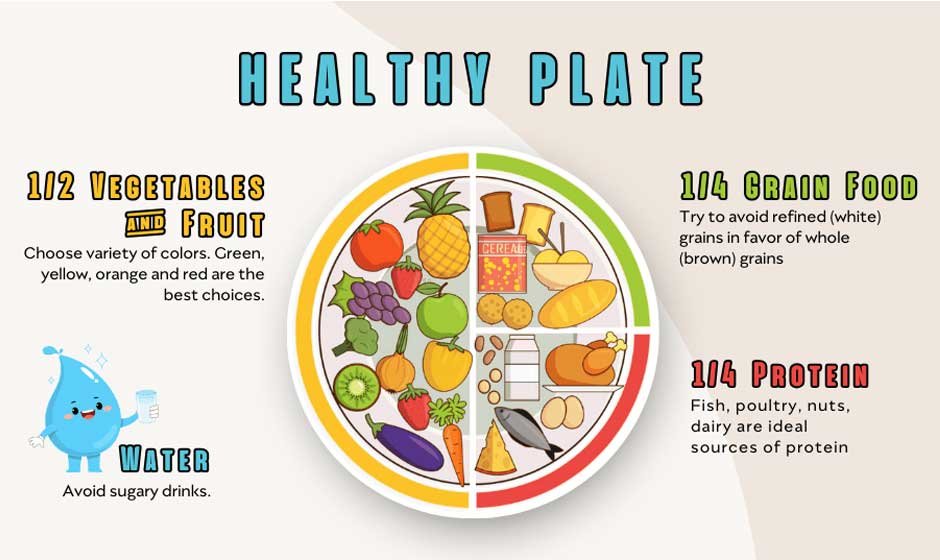Planning a meal also involves having a balanced plate to ensure long-term health, lots of energy and overall wellness. Our schedules are one of the reasons why we tend to resort to poor habits that involve convenience foods, which is an easy way out compared to eating healthy. Planning of meals with careful considerations can also aid in ensuring that all the plates hold valuable contributions when it comes to nutritional requirements in a day.
An equilibrated plate will include many types of food groupings in satisfactory quantities such as proteins, carbohydrates, good fats, and ample amounts of vegetables. Instead of being obsessed with strict rules, one should aim at creating meals that will be nutritious and enjoyable to eat. When done correctly, meal planning may serve as a credible way of ensuring an even health impact as well as simplifying and making day-to-day food intake more pleasant.
Understanding The Basic Food Groups
Any balanced diet should start with knowledge concerning the major food groups and their functions in the body. Protein plays a vital role in the repair of tissues, building the muscles, and the working of the immunity. Sources: lean slaughtered meat, fowl, fish, Leguminosae, tofu, eggs, and milk products. Carbohydrates are energy foods they contain whole grain, fruit, starchy veggies and legumes. Fats that are needed to balance hormones and enhance the health of the brain can be acquired through the use of nuts, seeds, avocados, and olive oil.
These are vegetables and fruits which contribute fiber, vitamins and minerals to the diet plate. Such foods help digestion and also cause satiety and prevent diseases. Creating a plate out of all these ingredients will assist in making meals nutritious and filling. When organizing the week, it is beneficial to consider how these groups may be turned and mixed to establish diversity but not complexity.
Managing Portions For Balance
As much as the presence of all the food groups may be there in a plate, balance can be destroyed by controlling the portion sizes. An excess of the latter and deficiency of the former may result in nutritional deficits or excessive calories. Visual visualization, like having half of the plate full of vegetables, one quarter full of protein and one quarter full of whole grains, is an easy and efficient method of serving food in parts.
Meal planning will also aid in the portion control since it helps eliminate mindless eating and impulsive decisions. This can be assisted by preparing ahead or using a meal delivery system that is portioned out to prevent overfeeding and selecting imbalanced choices. Intelligent preparation also helps in management of weight, and less waste of food at home.
Incorporating Variety Across Meals
Repetition is a common pitfall in home meal planning. Though life becomes easy when there is a routine, repetitive consumption of certain foods may be boring, and may cause you to ignore other nutrients. Having a mixture throughout the week adds up to new tastes and diversity in nutrients and vitamins as well. Simple change-ups that can make your meals interesting and healthy is the switch of proteins, rotation of vegetables and mix-ups with grains.
Variation of foods can also forestall confections as well as enhancing being able to adhere to nutritious eating. A meal plan delivery model which switches ingredients and recipes weekly may prove a good method of trying new food combinations without the stress of creating dishes out of nothing. This goes a long way in keeping the spirit around the eating table although attention is given to the side of balance and nutrition.
Planning Meals For Different Needs
The nutritional requirements of a person are unique depending on age, level of activity, medical conditions or the likes and dislikes of a person. One may have to realize that a balanced plate does not necessarily have to look the same with another one. As an example, athletes might need more protein and carbohydrates and people with diabetes might want to pay attention to fiber- rich foods and low-glycemic foods. The key to making real balanced plates is knowing about the individual needs and modifying the meal plan to that end.
Such an individual plan may be complemented with the references to the research of the reputable nutritional recommendations or by involving a specialist. Alternatively, meal delivery service providers also provide certain kinds of customization depending on dietary goals or restrictions. The added convenience enables one to juggle a balanced plate based on preference and preference without compromise.
Preparing Ingredients In Advance
Balance can be aided by having a kitchen that is well stocked with prepared food ingredients. Vegetables can be washed, chopped, grains cooked in a large quantity and protein pre-portioned to save time on weekdays and limit the likelihood of extending to less healthy means. It will promote home cooking which has the tendency of producing more nutritious meals as opposed to eating out or taking convenient foods or meals.
One can start to assemble balanced plates when ingredients are ready and available because this process will take less time. This is handy especially during a busy day where there is little time but it is needed to eat a healthy meal. Precooking is also an advantage because it can ensure more control over what gets served on a plate, which comes in handy to those who count nutrients.
Monitoring And Adjusting As Needed
Planning meals will be a continuous process rather than a one time endeavor. Styles of creating balanced plates should evolve as time, human interests, and ambitions vary. The monitoring of the reception of meals within the household and their maintenance of energy and wellness can be used to inform future decision making. Flexibility allows for improvements and prevents frustration.
Trial and fair judgement is involved in making progress in making healthier meal planning. Occasionally, modifying measures can include altering the kinds of recipes, the size of portions, or combining somewhat new food items. Delivery meal plans can serve as well-organized assistance to those who do not like to plan but still want to be able to make some adjustments with input and outcome.
Conclusion
Creating a balanced dish in meal planning is both science, as well as an art. It also involves knowing nutrition, organizational skills, preparation of foodstuffs, and flexibility with passing time. Adding variation, regulating quantities and customizing depending on dietary requirements are some of the factors associated with this process. It does not matter whether it is done alone or through the assistance of a meal delivery company, but the secret to success is considering preparation and the resolve to continue. As the strength of healthy dietary practices, meal planning also helps to relieve stress and enhance the overall experience of daily meals with practice.










